UNESCO AND THE ISSUE OF CULTURAL DIVERSITY Review ... - ITI
UNESCO AND THE ISSUE OF CULTURAL DIVERSITY Review ... - ITI
UNESCO AND THE ISSUE OF CULTURAL DIVERSITY Review ... - ITI
You also want an ePaper? Increase the reach of your titles
YUMPU automatically turns print PDFs into web optimized ePapers that Google loves.
moved into the 1970s. The 1975-76 Director General% Report linked cultural<br />
flourishing to the development and well-being of a nation as a whole (‘Culture in<br />
the service of development’, category 4A), the 1979-80 report highlighted that this<br />
challenge to the traditional dichotomy between economics and aesthetics was an<br />
essential element of the strategy to promote funding for culture (p. 50).<br />
The idea of endogenous or diversified development, a cornerstone of<br />
the 1977-78 Report, connected culture to development. For newly<br />
independent ,and developing countries, culture provided the unique direction<br />
for an autonomous path of progress that would be both politically liberating<br />
and economically empowering. Education subsection 1.2 and Social<br />
sciences section 2.1.2 of the 1977-78 Report, both entitled ‘appreciation and<br />
respect for cultural identity’, involved respecting cultural identity as a set of<br />
political and economic choices (rather than simply aesthetic ones), a<br />
prerequisite for greater equality among nations on the world stage.<br />
Beyond the question of power in international relations, another<br />
element was emerging in the study of culture and cultural policies. As noted<br />
in the 1977-78 Report, ‘the main new feature of the programme for the study<br />
of cultures is the importance given to cultural interactions’ (p. 40). As part of<br />
this change in direction, ‘an attempt is being made to study regional cultures’<br />
.-. and ...‘ greater interest is being shown in cultural regions that are in<br />
themselves centres of synthesis for a variety of cultural influences an<br />
contributions’. The question of intra-societal cultural diversity often had been<br />
underplayed or overlooked in the post-war context, when peace and<br />
understanding between sovereign states was a higher priority for<br />
international organizations than peace and understanding within those<br />
states. This was especially true for an organization like <strong>UNESCO</strong>, whose<br />
mandate explicitly prevented it from ‘interfering’ in the interna1 affairs of its<br />
members. In fact, it became increasingly clear that many of the same issues<br />
arose in intercultural relations within as between societies. In both cases, as<br />
noted in the 1977-78 Report, ‘the meeting organised led in fact to<br />
recommendations relating to plans of action that involve the study of<br />
convergent values, without disregarding the need to recognise, differences’<br />
(p. 40). While the suggestion that strategies might prove useful on both the<br />
intra- and inter-national levels would become an important part of the<br />
<strong>UNESCO</strong> platform, this balance between emphasising ‘convergent values’<br />
and ‘recognising differences’ proved easier to uphold in theory than it was to<br />
implement in practice.<br />
The Medium-Term Plan for 1977-82 identified a number of these same<br />
issues. This Plan included some of the following objectives, which help illustrate<br />
the priorities in the study of culture during that period :<br />
l Obiective 1.2: Promotion of appreciation and respect for the cultural<br />
identitv of individuals, qroups. nations and reaions. This objective showed<br />
that cultural identity could belong to a number of different entities<br />
(individuals, groups, etc.), with two implications: first, that interculturality<br />
does not simply begin where a state’s frontier ends; and second, that<br />
respect for cultural identity may entail rights for groups as well as for<br />
11




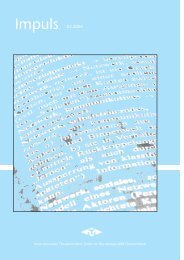
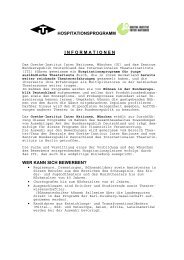
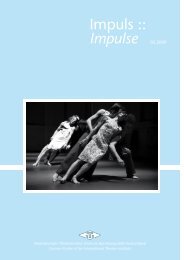
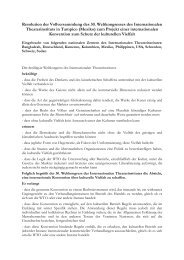
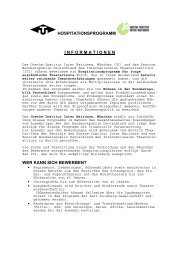

![Geschäftsbericht 2010 [pdf 2 MB] - ITI](https://img.yumpu.com/4380475/1/184x260/geschaftsbericht-2010-pdf-2-mb-iti.jpg?quality=85)